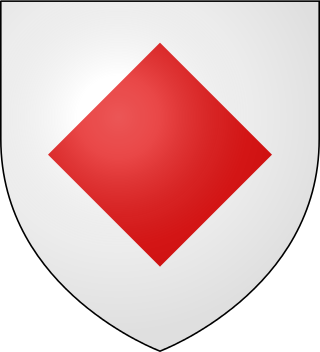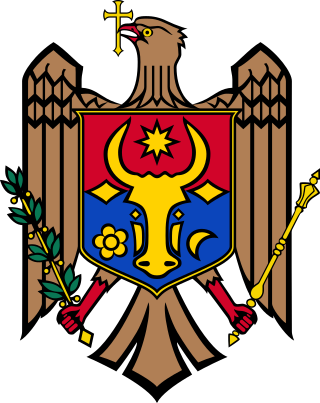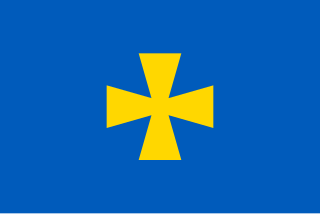| Coat of arms of Poltava Oblast | |
|---|---|
 | |
| Versions | |
 | |
| Armiger | Poltava Oblast |
| Adopted | 30 January 1998 |
| Shield | Azure |
The Coat of arms of Poltava Oblast is the official coat of arms of Poltava Oblast, Ukraine.
| Coat of arms of Poltava Oblast | |
|---|---|
 | |
| Versions | |
 | |
| Armiger | Poltava Oblast |
| Adopted | 30 January 1998 |
| Shield | Azure |
The Coat of arms of Poltava Oblast is the official coat of arms of Poltava Oblast, Ukraine.
The coat of arms consists of a shield divided into quarters by raspberry lozenge, crossed by argent and azure wavy belt.
In first part of lozenge is gold bow, accompanied by two or stars, in second is gold gates with three towers, accompanied by two gold stars.
Adopted colours:

Poltava is a city located on the Vorskla River in Central Ukraine. It serves as the administrative center of Poltava Oblast as well as Poltava Raion within the oblast. It also hosts the administration of Poltava urban hromada, one of the hromadas of Ukraine. Poltava has a population of 279,593.

The national flag of Ukraine consists of equally sized horizontal bands of blue and yellow.

Dnipropetrovsk Oblast, is an oblast (province) in simultaneously southern, eastern and central Ukraine, the most important industrial region of the country. It was created on February 27, 1932. Dnipropetrovsk Oblast has a population of about 3,096,485, approximately 80% of whom live centering on administrative centers: Dnipro, Kryvyi Rih, Kamianske, Nikopol and Pavlohrad. The Dnieper River runs through the oblast.

The coat of arms of Ukraine is a blue shield with a golden trident. It is colloquially known as the tryzub.

The coat of arms of Toronto is a heraldic symbol used to represent the city Toronto. Designed by Robert Watt, the Chief Herald of Canada at the time, for the City of Toronto after its amalgamation in 1998. The arms were granted by the Canadian Heraldic Authority on 11 January 1999.

Poltava Oblast, also referred to as Poltavshchyna, is an oblast (province) of central Ukraine. The administrative center of the oblast is the city of Poltava. Most of its territory was part of the southern regions of the Cossack Hetmanate. Population: 1,352,283.

A cross pattée, cross patty or Pate, or cross paty, also known as a cross formy or cross formée or Templar cross, is a type of Christian cross with arms that are narrow at the centre, and often flared in a curve or straight line shape, to be broader at the perimeter. The form appears very early in medieval art, for example in a metalwork treasure binding given to Monza Cathedral by Lombard queen Theodelinda, and the 8th-century lower cover of the Lindau Gospels in the Morgan Library. An early English example from the start of the age of heraldry proper is found in the arms of Baron Berkeley.

The lozenge in heraldry is a diamond-shaped rhombus charge, usually somewhat narrower than it is tall. It is to be distinguished in modern heraldry from the fusil, which is like the lozenge but narrower, though the distinction has not always been as fine and is not always observed even today. A mascle is a voided lozenge—that is, a lozenge with a lozenge-shaped hole in the middle—and the rarer rustre is a lozenge containing a circular hole in the centre. A lozenge throughout has "four corners touching the border of the escutcheon". A field covered in a pattern of lozenges is described as lozengy; similar fields of mascles are masculy, and fusils, fusily. In civic heraldry, a lozenge sable is often used in coal-mining communities to represent a lump of coal.

Lubny is a city in Poltava Oblast, central Ukraine. It serves as the administrative center of Lubny Raion. It also hosts the administration of Lubny urban hromada, one of the hromadas of Ukraine. Population: 44,089.

The coat of arms of Moldova is the national emblem of the Republic of Moldova. It was designed by the Moldovan artist Gheorghe Vrabie.

Hadiach, sometimes spelled Hadyach, Gadyach, Gadiach, Haditch, or Hadziacz, is a city in Myrhorod Raion, Poltava Oblast (province) in the central-east part of Ukraine. It hosts the administration of Hadiach urban hromada, one of the hromadas of Ukraine. Hadiach is located on the Psel River. Population: 22,851.

Zmiiv or Zmiyiv from 1976 to 1990, is a city in Chuhuiv Raion, Kharkiv, Ukraine. It hosts the administration of Zmiiv urban hromada, one of the hromadas of Ukraine. The population in 2001 was 17,063, falling to 13,737.

The coat of arms of Cantabria has a rectangular shield, round in base and the field is party en fess. In field azure, a tower or crenellated and masoned, port and windows azure, to its right a ship in natural colours that with its bow has broken a chain sable going from the tower to the dexter flank of the shield. At the base, sea waves argent and azure, all surmounted in chief by two male heads, severed and haloed. In field gules, a disc-shaped stele with geometric ornaments of the kind of the Cantabrian steles of Barros or Lombera. The crest is a closed royal crown, a circle of jeweled gold, made up of eight rosettes in the shape of acanthus leaves, only five visible, interpolated with pearls, and with half-arches topped with pearls raising from each leaf and converging in an orb azure, with submeridian and equator or, topped with cross or. The crown, covered in gules.

The coat of arms of Kropyvnytskyi is one of the city's symbols reflecting its past and the controversies of its history.

The coat of arms of the German state of Thuringia was introduced in 1990. Like the 1949 coat of arms of Hesse it is based on the Ludovingian lion barry, also known as the "lion of Hesse", with the addition of eight mullets.

The coat of arms of the City of Christchurch, also known as the armorial bearings, is the official symbol of the City of Christchurch, New Zealand. They were granted to the city by the College of Arms by letters patent on 21 February 1949.

Novorossiya Governorate was an administrative-territorial unit (guberniya) of the Russian Empire, which existed in 1764–1783 and again in 1796–1802. It was created and governed according to the "Plan for the Colonization of New Russia Governorate" issued by the Russian Senate. It became the first region in Russia where Catherine the Great allowed foreign Jews to settle.
The following gallery displays the historical and official coats of arms of Ukraine.
Klymivka is a village in Poltava Raion of Poltava Oblast of Ukraine. It belongs to Lanna rural hromada, one of the hromadas of Ukraine. Their local government body is called the Klymivka Village Council.

The Cossack cross is a type of the Templar cross used by the Ukrainian Ground Forces. It is frequently used in Ukraine as a memorial sign to fallen soldiers and as military awards.